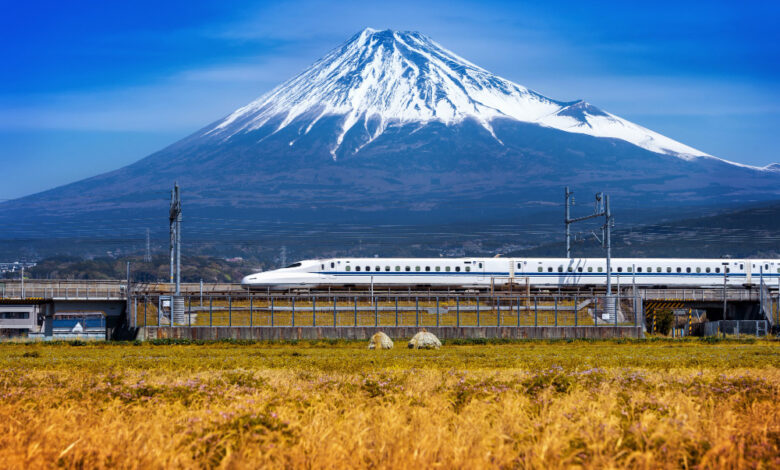
Sixty years after the launch of the world’s first high-speed train, rail enthusiast Paul Carter journeys aboard the bullet train along the so-called ‘New Golden Route.
Standing on Platform 19 at Tokyo Station, a lively hub of modern rail transport, it’s hard to imagine that 60 years ago this year, the first Shinkansen departed from here, making its way to the port city of Osaka.
With its distinctive, sloping nose and sleek, aerodynamic curves, the Shinkansen was the world’s first high-speed train, quickly earning international fame as the “bullet train.”
The high-speed Tokaido Shinkansen line connecting Tokyo and Osaka came to be known as “The Golden Route” by travelers, offering a swift journey between two of Japan’s most vibrant cities. Along the way, it passed the majestic Mount Fuji and the historic city of Kyoto, covering the distance in under two and a half hours.
Amid the bustling crowds boarding and disembarking the Shinkansen — famous for its precise, on-the-dot timing — I met Naoyuki Ueno, a former Shinkansen driver who now holds a senior executive position at Central Japan Railway Company. He shared that since its debut, the Shinkansen has transported an incredible 6.8 billion passengers across Japan.
I take great pride in the Shinkansen,” he said. “As a Japanese citizen, it fills me with pride.
Since the inaugural route launched in 1964, the Shinkansen network has expanded significantly, making it easier and faster for travelers to explore Japan’s stunning landscapes and distant cities. Today, there are nine Shinkansen lines spanning the islands of Hokkaido, Honshu, and Kyushu.
In March 2024, the latest extension of the Hokuriku Shinkansen line opened, connecting the route to Tsuruga. Known as “The New Golden Route,” this new extension formed the foundation of my journey from Tokyo to Osaka for the BBC series The World’s Greatest Train Journeys. I relied on the Shinkansen as the backbone of my travels, while also connecting to local services and other lines. One of the great advantages of the bullet train is how quickly it can whisk you out of the city, offering the freedom to explore Japan’s lesser-known corners in no time at all.
After stepping off the Shinkansen in Toyama, just two hours from Tokyo, I boarded a quaint single-line train to the picturesque resort town of Unazuki Onsen. Renowned for its traditional Japanese hot springs (onsen) and surrounded by the breathtaking beauty of Kurobe Gorge, it felt worlds away from the hectic energy of Tokyo. The town’s connection to the onsen is so strong that even the train station features a hot foot spa at the end of its platform.
My guide, Hashimoto Yukinori, or “Yuki,” took me to one of his favorite onsen, offering sweeping views of the valley. He explained that traditionally, onsen are enjoyed naked and communally. (Fortunately, for the sake of the global television audience, we were granted special permission to wear swimsuits, which is typically not allowed.) While incredibly relaxing, onsen are not for the faint-hearted: the water was around 40°C, and Yuki mentioned that sometimes it can be even hotter.
“In Japan, we have many active volcanoes, so there are hot springs all over the country,” he said. “They’re really relaxing and healing. Nature holds great importance for the Japanese because our islands are mountainous. We have many volcanoes and… many disasters. So, we have both a fear of nature and a deep respect for it.”
However, the real highlight of Unazuki Onsen for train enthusiasts like me is the Kurobe Gorge Railway. This narrow-gauge line was originally built to assist in constructing the massive Kurobe Dam. Running through a forested ravine and covering 20km of breathtaking scenery, it offers the perfect chance to connect with nature.
Afterward, I hopped back on the Shinkansen and headed to Kanazawa, a city with a rich samurai history and a reputation for gold. Known for producing 99% of Japan’s gold leaf, Kanazawa beautifully blends the old with the new. Despite its vibrancy, the city has an unexpectedly calm atmosphere. After indulging in some extravagant gold leaf-covered ice cream, it was time to continue my journey.
Next, I made my way to Wajima on the Noto Peninsula, an area recently struck by disaster. On New Year’s Day 2024, a powerful 7.6-magnitude earthquake devastated the city and surrounding regions. Due to the damage, the city is currently inaccessible by train. My trip involved taking a small local train to Anamizu and then a short drive to Wajima.
But what arrived at the station was no ordinary train. The carriages were covered in vibrant Pokémon characters, including Pikachu and Bulbasaur. I later learned that this special train was introduced to bring joy to local children who had been affected by the earthquake.
Visiting Wajima was a sobering and humbling experience. Many buildings remained where they had fallen, often partially collapsed. It felt like walking through the set of a disaster film, yet this was all too real, with real people left to rebuild. My purpose there was to learn about Wajima-nuri, the town’s traditional lacquerware. For the people of Wajima, reviving their lacquerware industry is seen as a key part of restoring their culture and way of life.
Takahiro Taya, a tenth-generation lacquerware artisan in Wajima, shared with me, “If the earthquake destroyed our industry, many people would lose their jobs. So, I must rebuild this industry—not only for the craftsmen, but also for their customers. And I have a son. He’s two years and eight months old. I want to pass this craft down to him.”
Afterward, I took one last ride on the Shinkansen to complete my journey to Osaka, Japan’s second-largest city. As I left the rural landscapes behind and approached the sprawling urban centers, I reflected on how much Japan has evolved in the past 60 years. Today, it’s a country brimming with ultramodern cities and cutting-edge technology, yet its people still take immense pride in their ancient traditions and rural roots. In many ways, the Shinkansen, which links the country’s bustling metropolises with its far-flung regions, embodies Japan as a whole: a nation that is both embracing the future and holding tightly to its past.
Japan is a land of discovery, rich with contrasts and extremes. The Shinkansen has revolutionized travel by making even its most remote corners easily accessible in a fraction of the time. While high-speed rail is primarily about efficiency, it offers so much more than just quick transportation. It gives travelers the chance to step off the train, take in the surroundings, and truly venture off the beaten path. Happy birthday, Shinkansen. Here’s to the next 60 years.




